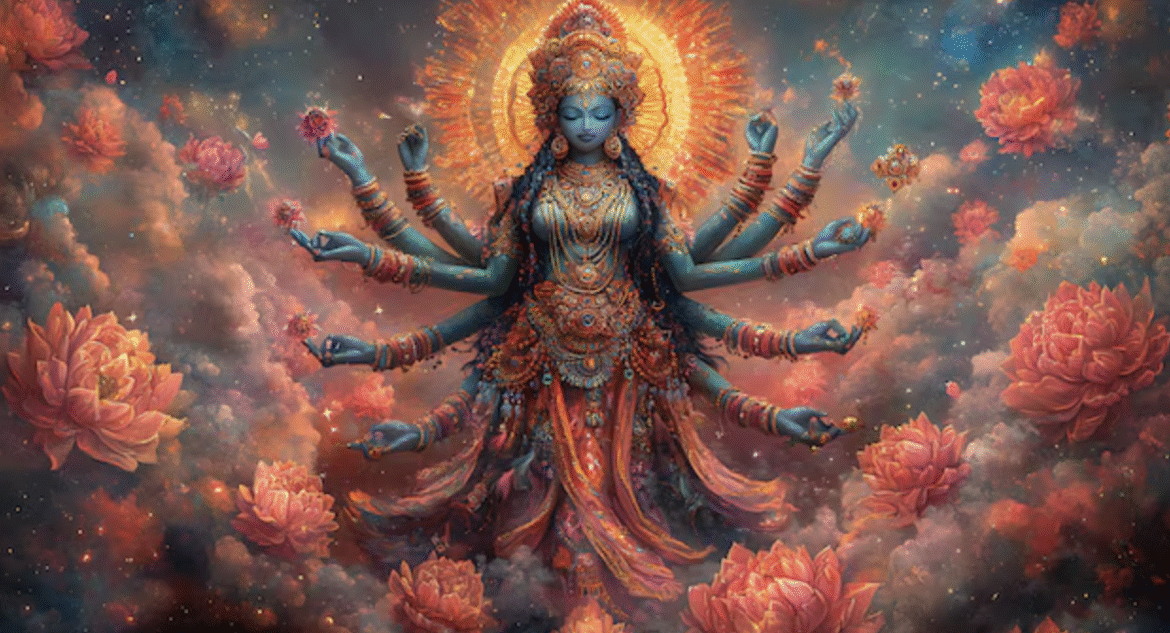Long before the world divided power by gender, Bhāratavarṣa (ancient India) knew a secret: the universe itself was born from the womb of the Divine Feminine.
She was not a concept. She was Śakti – the pulsating energy that moves the stillness of Śiva, the consciousness that births creation, sustains worlds, and dissolves illusion.
In that vision, to honor woman was to honor the very Source of Life. She was Mātṛ, Devī, Guru, Prajñā not a possession, not a weaker vessel, but the embodiment of the eternal principle that animates existence.
1. Shakti in the Vedas – The Feminine as Cosmic Power
The earliest hymns of the Ṛg Veda speak not of patriarchy but of partnership of the Divine as dual yet one, motion and stillness, power and awareness.
In the Devī Sūkta (Ṛg Veda 10.125), the seeress Vāk Ambhṛṇī declares:
“I am the Queen, the gatherer of treasures,
the knower, first of those who are worthy of sacrifice.
Through me all eat, breathe, and see. I am the power that makes the strong strong.”
Here, the Divine Feminine proclaims herself as the source of all manifestation,
the intelligence behind gods and men alike.
Women in Vedic times were ṛṣikās (female sages). They composed hymns, performed yajñas, and discussed philosophy with kings and ascetics. Names like Lopāmudrā, Apālā, Ghoṣā, Maitreyi, and Gārgī shine in the Rigvedic canon voices of wisdom, inquiry, and devotion.
Maitreyi asked Yājñavalkya in the Bṛhadāraṇyaka Upaniṣad:
“If the whole earth were mine and filled with wealth, would I be immortal?”
Yājñavalkya replied, “No. Wealth gives no immortality.”
Thus she became the symbol of inquiry the soul that seeks truth beyond possessions.
2. The Feminine Archetypes – Shakti Manifest in Every Form
Ancient Bharat saw divinity mirrored through the lives of women. Not idealized saints, but living expressions of the eternal Shakti.
- Sītā – the serenity of dharma amidst trial; the earth’s forgiveness.
- Draupadī – the fire of justice; the voice that refuses silence before wrong.
- Kuntī – the wisdom of surrender; the mother who shaped destiny through faith.
- Rādhā – the ache of divine love that transcends worldly definition.
Men were known through women, not the other way around – Kuntī-putra Arjuna, Sītā-Rām, Rādhā-Kṛṣṇa.
Because in the Vedic mind, the feminine gave sanctity, legitimacy, and soul. The masculine without the feminine was incomplete like a flame without its light.
3. Ardhanārīśvara – The Metaphysics of Balance
The ultimate symbol of this unity is Ardhanārīśvara – half Śiva, half Śakti. It represents not gender, but metaphysical harmony.
Śiva without Śakti is śava – a corpse.
Consciousness without energy is inert. The universe exists because of their union, Purusha (pure awareness) and Prakṛti (creative power).
This is not mythology but philosophy, a teaching that the divine resides in duality as complement, not conflict. Man and woman, mind and heart, logic and intuition all are two wings of one bird.
In the words of Śvetāśvatara Upaniṣad:
“He is the cause, She is the action;
together they weave this endless tapestry of being.”
4. Women as Seekers, Teachers, and Rulers
Historical and textual evidence shows women as participants in every sphere of life education, governance, art, and spirituality.
In Mahābhārata, we find queens like Sulabhā, who engaged King Janaka in philosophical debate and defeated him in logic. In Kāṭhaka Saṁhitā and Gṛhya Sūtras, women were permitted to perform Vedic yajñas.
Marriage was never ownership but a partnership, a saṁskāra, a sacred union of energies, not a social contract of domination. The concept of Ardhanginī “half of the being” symbolized that man and woman were two reflections of one consciousness.
5. The Spiritual Symbolism – From Devī to Dharma
The woman was seen not as property but as Prakṛti, the expression of dharma itself. She was the river Sarasvatī, the knowledge that flows; the fire Agni, the warmth that sustains; the earth Bhūmī, the patience that nourishes.
The Devī Māhātmya (in Mārkaṇḍeya Purāṇa) hails the Goddess as:
“By You, this universe is borne,
by You, it is protected, O Devī,
by You it is consumed at the end.
You are the Supreme Knowledge, eternal and boundless.”
To see a woman was to see a fragment of that Divine Power, not just biologically, but cosmically.
6. The Living Philosophy – Dharma Through the Feminine
In ancient Bharat, spirituality was not an abstract ideal; it was a living rhythm. Festivals, art, rituals, and poetry revolved around feminine energy – Navarātri, Durga Pūjā, Kanyā Pūjan, not as idol worship, but as remembrance that the universe breathes through the feminine principle.
Even kings bowed before the goddess before going to war. Every creation began with a prayer to Śakti.
The Atharva Veda says:
“May we be surrounded by women who are wise, skilled in speech, and fearless in thought.”
This was the dharma of the land – reverence, not repression.
Conclusion – When Divinity Walked in Human Form
Before dogma replaced dialogue, before fear replaced freedom, Bharat was a civilization where every woman was seen as a living shrine.
She was the mother who birthed knowledge,
the beloved who inspired devotion,
the warrior who upheld dharma,
the teacher who lit the path.
To honor her was to honor the Divine itself.
And so, the golden age of Bharat was not measured by wealth or conquest but by how deeply it recognized the sacredness of the feminine. That recognition is not lost, it only sleeps, waiting to awaken once more.


Leave a Reply